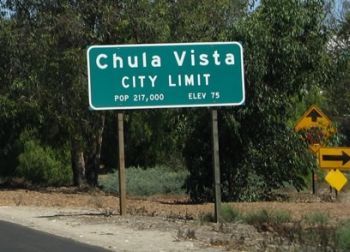
Publisher:
Bonnie King
CONTACT:
Newsroom@Salem-news.com
Advertising:
Adsales@Salem-news.com

~Truth~
~Justice~
~Peace~
TJP
Jul-14-2010 21:15

 TweetFollow @OregonNews
TweetFollow @OregonNews
Tijuana News: Welcome to New Tijuana, California
Salem-News.comPeople are immigrating to the U.S. for different reasons these days; some to escape poverty, others to avoid kidnapping.
 Near Chula Vista is a neighborhood where those who cross the border find refuge; and with that come a host of problems that affect both sides of the border. Courtesy: aaroads.com |
(CHULA VISTA, Calif.) - They call it New Tijuana. Located near Chula Vista, California, East Lake Terrace embraces Mexican immigrants who’ve fled across the border from nearby Tijuana to escape crime and violence. Surrounded by new businesses, pricey homes built by immigrant laborers and a nice park with ample sports facilities, the neighborhood is one manifestation of the border’s new, largely silent migration.
Christian Ramirez, coordinator of migration programs for the American Friends Service Committee, said the affluent immigrants differ from the working-class migrants who have established roots in Logan Barrio and other parts of San Diego County.
“You can see perfectly the confection of two different worlds in the Mexicans who escape because of the economic situation and those who come here looking to avoid a kidnapping,” Ramirez told a Mexican reporter.
Maria Flores knows the story. The wife of a small trucking firm operator who was kidnapped back in 2006, Flores now runs the business by “remote control” from the safe quarters of Chula Vista.
A video camera in a business situated across the street from Pedro Flores’ firm captured the man’s detention by a group of about 20 men wearing uniforms of the old Federal Agency for Investigations. Many residents suspect police of being behind numerous kidnappings in the Tijuana area.
According to Flores, the owner of the neighboring business was likewise kidnapped and now lives “completely mutilated” in Chula Vista. For Flores, exile amid her husband’s continued disappearance has meant a life of anxiety and “spiritual death.”
The migration of Tijuana’s well-to-do took off after 2005, when kidnapping soared 300 percent in one year, according to one estimate.
Coinciding with the municipal administration of Tijuana Mayor Jorge Hank Rhon (2004-2007), the next few years witnessed an escalation of narco-violence as well as the deployment of the Mexican army. At the same time, Tijuana’s tourism industry continued in a downward spiral, giving another impetus to migration.
Considering the tightened US border security after 9-11 as the prelude to curtains, Juan Palombo Saucedo of the Tijuana Association of Tourism Merchants said subsequent security measures by the US and Mexican governments combined with media reports of violence sealed the last nails on the coffin of the Revolution Avenue tourist district.
 Tijuana's tourism district is sort of quiet these days. |
Overall, more than 13,000 Tijuana businesses have shuttered their doors since 2007, said Mario Escobedo, president of the Tijuana Chamber of Commerce.
Tijuana’s famed tourist quarter experienced the same fate as another border town that once greeted US visitors, Ciudad Juarez, where a doomsday-like dialectic of economic crisis, public insecurity and tougher border crossings deprived many people of a means of making a living and encouraged middle and upper-class migration across the border.
Ironically, the moneyed migration sprouted seeds of business activity in places like Chula Vista and El Paso, Texas, precisely at a time when the Great Recession was shriveling up the economic landscape elsewhere in the US.
Mexican authorities like Jose Francisco Blake Mora, the Baja California state government secretary who was named the Calderon administration’s new Interior Minister on July 14, argue that the public safety situation in Tijuana is improving. Chamber of Commerce official Escobedo concurred with Blake to an extent, adding that no businessmen have been kidnapped in 2010.
“That’s not to say things are resolved, because we can’t deny that many people emigrate for (violence-related) reasons,” Escobedo was recently quoted. “Nonetheless, I believe that things are getting better little by little and some of those who left are beginning to return.”
General Alfonso Duarte Mugica, commander of the Second Military Zone, recently contended that security forces have dismantled the major drug cartels that, with the collusion of Tijuana’s now-purged municipal police, strode about the border city like “Pedro in His House,” as the old Mexican saying goes.
Case in point: the Baja California attorney general’s office announced this week the capture of six men linked to 32 murders allegedly committed at the behest of Teodoro “El Teo” Garcia Simental, a former lieutenant of the Arellano Felix organization who split off from the old cartel and is now detained by the Mexican government. General Duarte said the bigger syndicates have been replaced by smaller bands of delinquents from Guadalajara, Monterrey and other places.
Fernando Ocegueda Flores, secretary-general of the Citizens Association Against Impunity, a group which represents relatives of disappeared and kidnapped persons, challenged the notion of an improved public safety conditions.
In an interview with the Mexican press, Ocegueda said kidnappers have grown less picky and now snatch small business people and market vendors for ransoms ranging from $4,000 to $8,000. In addition to the San Diego area, Mexican families have fled north to Los Angeles and south to other parts of Mexico, the human rights activist added.
Felix Velez, head of Mexico’s National Population Council (Conapo, said this week that the Mexican government does not know how many people have abandoned their homes for the US and other destinations because of narco or criminal violence. According to Conapo, 108.4 million people inhabited Mexico as of mid-2010. The number was up from 107.5 million in 2009. About 12 million persons born in Mexico now live in the US, Velez said.
Sources:
- El Sol de Tijuana, July 14, 2010. Article by Manuel Cordero.
- Frontera, July 13 and 14, 2010.
- La Jornada/Notimex, July 12, 2010.
- El Universal, June 22, 2010 and July 13, 2010. Articles by Julieta Martinez, Ignacio Alvarado, Alberto Cuenca, Thelma Gomez, Juan Gerardo Mejia, Elena Michel, and Notimex.
Frontera NorteSur (FNS): on-line, U.S.-Mexico border news Center for Latin American and Border Studies New Mexico State University Las Cruces, New Mexico
Articles for July 13, 2010 | Articles for July 14, 2010 | Articles for July 15, 2010


Quick Links
DINING
Willamette UniversityGoudy Commons Cafe
Dine on the Queen
Willamette Queen Sternwheeler
MUST SEE SALEM
Oregon Capitol ToursCapitol History Gateway
Willamette River Ride
Willamette Queen Sternwheeler
Historic Home Tours:
Deepwood Museum
The Bush House
Gaiety Hollow Garden
AUCTIONS - APPRAISALS
Auction Masters & AppraisalsCONSTRUCTION SERVICES
Roofing and ContractingSheridan, Ore.
ONLINE SHOPPING
Special Occasion DressesAdvertise with Salem-News
Contact:AdSales@Salem-News.com



Terms of Service | Privacy Policy
All comments and messages are approved by people and self promotional links or unacceptable comments are denied.
DuJohn Willits September 16, 2010 12:57 am (Pacific time)
WTF? No one here in Chula Vista calls any neighborhood "New Tijuana." Lame.
lol July 16, 2010 7:18 pm (Pacific time)
nice writing Senor Anonima
RealTijuana Blogspot July 16, 2010 4:38 pm (Pacific time)
P.S. About your cut-in head, "People are immigrating to the U.S.…", it bears mentioning that immigration is always from somewhere while emigration is always to somewhere.
Editor: Thank you very much. If you have information to share please feel free.
RealTijuana Blogspot July 16, 2010 4:19 pm (Pacific time)
For as long as Europeans have lived here, the upper class of Tijuana have preferred to live north of the border. Before they lived in Eastlake they lived on the Coronado Strand. Before that, they lived in downtown Chula Vista. A hundred years ago there were tax advantages to living north of the border. Then it became chic to do so. Nowadays, however, people like José Galicot and Ascan Lutteroth have been vocal about why they prefer to live in Tijuana. Many of our present leaders now believe it's chic to live here. Eastlake is a new housing development. Before there was Eastlake there was nothing but scrub brush. Eastlake's development occurred at the same time that the Tijuana cartel had been protecting its native turf from being taken over by the federal government's drug cartel. The local cartel won.
Don Carlos July 15, 2010 8:36 am (Pacific time)
Blake Mora is Secretary of State, not of Interior. There are not official kidnappings (it becomes official and part of the stats when relatives reports then to authorities)on 2010.
Last note, when any news of violence have the headline Tijuana, keep in mind, that the actual tourists corridors are the safest.
Editor: Don, comments are approved by living people, sometimes there is a delay, thank you.
[Return to Top]©2025 Salem-News.com. All opinions expressed in this article are those of the author and do not necessarily reflect those of Salem-News.com.